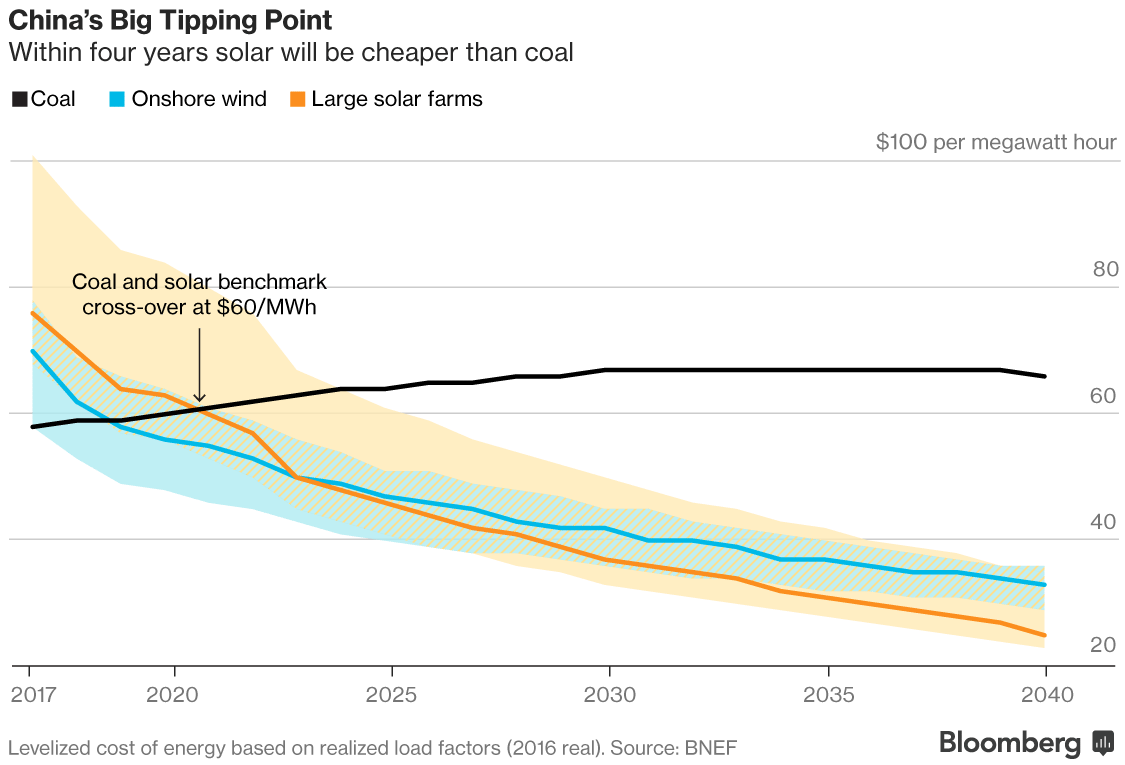Mankind changed its energy paradigm many times, the initial energy consumed was only in the form of food: berries, fruits, bison, and so on. Then man replaced blueberries with mammoths for more convenient and powerful sources of energy: wood, coal, oil, nuclear energy. Each transition lasted for dozens and hundreds of years and put the next gigawatts at the service of humanity - it became warm in the houses, there appeared from where to recharge the smartphone and millions of people plow the vast expanses of forests, fields and rivers on cars and trains. Nevertheless, the question whether the current energy pattern will disappear into the air is not worth it - only the time when this will happen is incomprehensible.
The energy division of the Bloomberg agency recently
published its annual forecasts for renewable energy, which is claiming to be a new energy system. Below is a graph of the distribution of electricity generation depending on the source:
 The black color indicates the share of electricity generation on fossil fuels — coal, gas, and a small proportion of oil. Gray - nuclear and hydropower. Dark blue renewable energy (RES) - solar and wind.
The black color indicates the share of electricity generation on fossil fuels — coal, gas, and a small proportion of oil. Gray - nuclear and hydropower. Dark blue renewable energy (RES) - solar and wind.According to Bloomberg, despite repeated growth even by 2040, renewable energy will take up only a third of the electric balance - 34%. Accordingly, the era of renewable energy (if there is one) is shifted somewhere far away - in the second half of the century. At the same time, the schedule actually does not show all the difficulties that are often forgotten in such arguments: electricity is only a smaller part of the energy consumed by humanity. The main share comes from the direct use of oil, gas and coal in engines, furnaces, and so on, so the share of renewable energy from total energy is about two times less.
It may seem that I am a gloating techno-pessimist, but this is not so. Two years ago, I
noted that solar energy was retrospectively underestimated, generation grows exponentially and will develop further, but due to the low base effect and other problems, generation growth will be slower than we would like. Growth growth - strife.
As it too often happens in the modern world, RES rests on money. Solar panels are
becoming cheaper for 40 years, and not just like that, but exponentially. But still not enough. Wind energy, contrary to popular belief, can compete at cost with the traditional - the study of the IEA and the NEA (English)
here , simpler
here . But with its spread, a problem of aesthetic character arises: between the options “beautiful landscapes without wind turbines” and “lawns with wind turbines”, residents tend to support the first option - this is especially true for densely populated regions. The solution is the removal of wind turbines into the sea, to which Europe has shifted its focus,
raising feed-in-tariff subsidies to this type of generation. But sea windmills is an
expensive thing, and again everything depends on money.
“Bloomberg” gives the following cost estimate for the example of China:
 The black line is the cost of coal power generation, orange and blue - solar and wind. The vertical axis is $ / MW * h and not from zero.
The black line is the cost of coal power generation, orange and blue - solar and wind. The vertical axis is $ / MW * h and not from zero.Only in the early 2020s will solar energy become cheaper than coal. But this applies only to new power plants, in which the costs of construction and direct activities are included in the cost price. After all, the old power plants have already “recaptured” capital expenditures and only operating costs in their cost - maintenance and the coal itself, which is now cheap. Therefore, squeezing the old generation from the market at a cost of $ 20- $ 30 per MWh is another problem and for a couple of decades it has not been solved by market mechanisms.
As a result (if the “Bloomberg” forecast turns out to be true), mankind will have to rely on fossil fuels for a long time and if something breakthrough does not happen, the current trends in the transition to new sources of energy will be spread over decades.